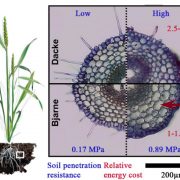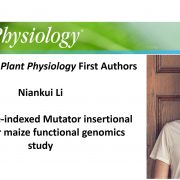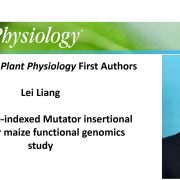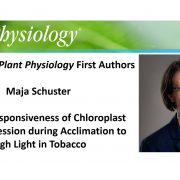
Regulation of Pavement Cell Morphogenesis
Plant Physiology, Plant Physiology: On The InsideSimple plant cell morphologies, such as cylindrical shoot cells, are determined by the extensibility pattern of the primary cell wall, which is thought to be largely dominated by cellulose microfibrils, but the mechanism leading to more complex shapes, such as the brick-shaped or jigsaw-like patterns…

How Carrots Get Their Colors
Plant Physiology, Plant Physiology: On The InsideCarrot (Daucus carota ssp. sativus) are classified into two groups: the carotene group (variety sativus) and the anthocyanin group (variety atrorubens). Carotene group members, also known as nonpurple carrots, accumulate massive amounts of carotenoids in their roots. Anthocyanin group members, also known…

A Circadian Clock Protein Regulates Fitness under Water Limitation
Plant Physiology, Plant Physiology: On The InsideThe circadian clock of plants coordinates many molecular, physiological and metabolic processes to optimize the plant's health and survival in an ever-changing environment. The core circadian clock component TIMING OF CAB EXPRESSION1 (TOC1) integrates environmental stress responses in plants through…

Systems Analysis of Lignin Mutants
Plant Physiology, Plant Physiology: On The InsideLignin is a complex polymer deposited in plant cell walls that provides mechanical support and facilitates the transport of water and solutes through the vascular system, and aids in plant defense. Lignin waterproofs plant cells by providing a hydrophobic environment by chemical bonding with cellulose…

Burying your head in the sand: heading belowground to find future targets of selection in roots
Plant Physiology, Plant Physiology: News and Views, ResearchAuthor: Skelton, Robert Paul
[email protected]
Institution: Department of Integrative Biology, University of California Berkeley, Berkeley, CA, 94720.
Burying one’s head in the sand is usually synonymous with avoiding an issue, but in this volume of Plant Physiology Colombi et al. (2019)…

Recognizing Plant Physiology first authors: Niankui Li
Plant Physiology, Plant Physiology: Author ProfilesNiankui Li, co-first author of A sequence-indexed Mutator insertional library for maize functional genomics study
Current Position: Ph.D. Student. Molecular & Environmental Plant Sciences, Texas A&M University, USA
Education: Master of Agronomy, College of Agronomy and Biotechnology, China…

Recognizing Plant Physiology first authors: Lei Liang
Plant Physiology, Plant Physiology: Author ProfilesLei Liang, co-first author of A sequence-indexed Mutator insertional library for maize functional genomics study
Current Position: Ph.D. Candidate. State Key Laboratory of Plant Physiology and Biochemistry, National Maize Improvement Center, College of Agronomy and Biotechnology, China Agricultural…

Recognizing Plant Physiology first authors: Maja Schuster
Plant Physiology, Plant Physiology: Author ProfilesMaja Schuster, fist author of Limited Responsiveness of Chloroplast Gene Expression during Acclimation to High Light in Tobacco
Current Position: Phd student, Max Planck Institute of Molecular Plant Physiology, Germany
Education: B.Sc. in Life Science with focus on Biochemistry and M.Sc. in Bioinformatics
Non-scientific…

Cytoskeletal Targets of an Auxin Transport Inhibitor
Plant Physiology, Plant Physiology: On The InsideThe phytohormone auxin plays critical roles in various plant developmental programs by controlling cell expansion and polarity, as well as organ patterning. Auxin action relies on polar transport through different plant tissues. Auxin transport inhibitors are important tools for understanding auxin-dependent…

